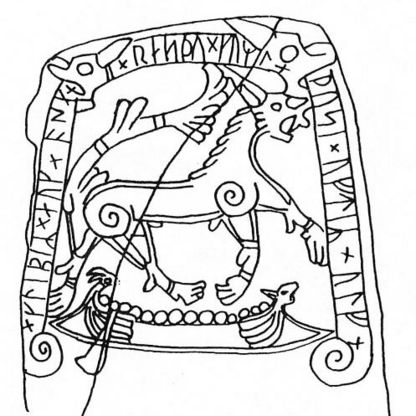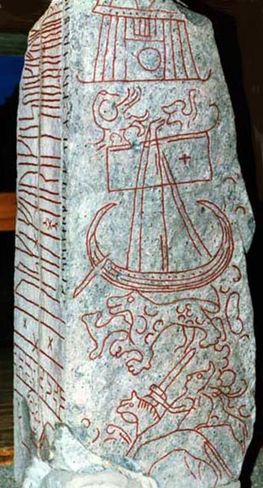

The ships on the rune stones
There are comparatively few rune stones with ship-representations. Eight are known from Denmark and seventeen from Sweden, while Norway only has one example from the medieval period. A couple of the ship-representations show Thor’s fishing expedition and can therefore not be depictions of longships. On the other hand a number of stone ships have shields along the gunwale and this reveals that they are intended to represent ships for warriors. Among the ships with shields there are two different forms of hull. The one type has obvious stem-beards fore and aft so that the ship comes to resemble a classical war-galley from the Mediterranean. The clearest example of this type is the rune-stone ship from Tullstorp in Skåne, which has 15 shields along the side of the ship but, on the other hand, no rigging. Mast and sail are also lacking from most of the other ships with the same hull-form but a single example from Spentrup in Jutland does have a mast and stay. The ships with stem-beards can be dated to between 950 and 1025 and most of them come from the present Denmark and Skåne, although there is one example from Östergötland.
The other hull-form that occurs is only seen once together with shields and there it is only partially preserved. This is on the rune stone from Sønder Kirkeby in Falster in Denmark, which has been cut to shape and built into the church wall. The hull-form here is the same as that with which we are familiar from the archaeological ship-finds, although we cannot see the ends of the stems on the picture. It is this normal hull-form that we find on the majority of the other rune stones with ship-representations. The shields do not all survive on the Sønder Kirkeby depiction but there would probably have been more than 12 of them originally.

One particular Swedish rune stone occupies a quite special position. This is the Sparlösa stone from Västergötland. It is quite unlike the other Swedish rune stones, being dated to about 800 and apart from the fact that it is exceptionally richly illustrated, it has a small cross in the ship’s sail. Christian symbolism is common in connection with the Swedish rune stones of the eleventh century but it is very unexpected in the present context. The ship-representation on the Sparlösa stone is also unusual. Its hull is low and the planks in the sides of the ship are marked. The stems are long and high-sweeping so that they arch back over the ship and end in points. The ship has a side-rudder. Oar-holes are indicated in the uppermost strake, 13 altogether. The rig is shown with mast, yard, sail and shrouds or stays, and at the very top of the mast a pennant is flying – a surprising wealth of detail.
Danish text: Jan Bill
Translation: Gillian Fellows-Jensen